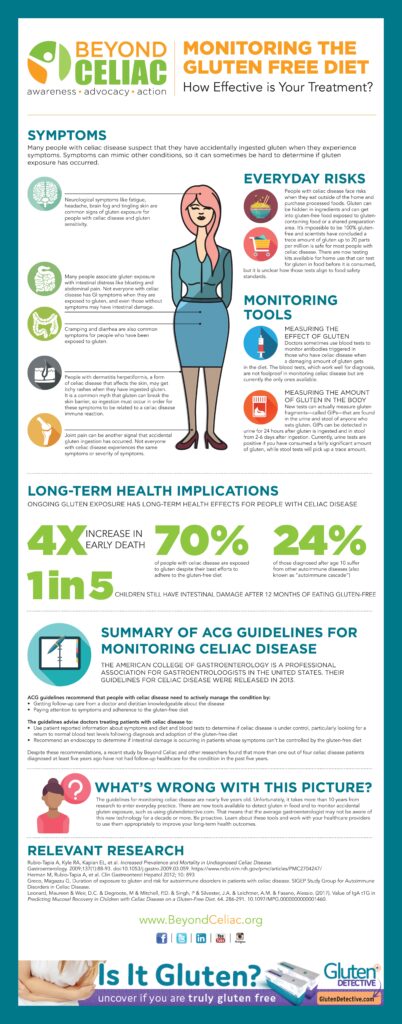Living with celiac disease can present its fair share of challenges, but with the right approach, you can lead a healthy and fulfilling lifestyle. Whether you’ve recently been diagnosed or have been managing this condition for years, this article will provide you with practical tips and advice to help you navigate the complexities of celiac disease. From understanding important dietary considerations to finding support networks, you will gain valuable insights on how to cope with celiac disease and ensure a vibrant and enjoyable life.

Understanding Celiac Disease
Celiac Disease is an autoimmune disorder that affects the small intestine and is triggered by the consumption of gluten. Gluten is a protein found in grains such as wheat, barley, and rye. When someone with celiac disease ingests gluten, it triggers an immune response that damages the lining of the small intestine, making it difficult for the body to absorb essential nutrients from food. This can lead to a range of symptoms and complications.
Causes of Celiac Disease
The exact cause of celiac disease is still unknown, but it is believed to be a combination of genetic and environmental factors. People with a family history of celiac disease are at a higher risk of developing the condition. Additionally, certain medical conditions, such as Type 1 diabetes and Down syndrome, are associated with an increased risk of celiac disease. It is important to note that celiac disease is not a food allergy or an intolerance, but an autoimmune disorder.
Diagnosing Celiac Disease
If you suspect you may have celiac disease, it is important to seek a proper diagnosis from a healthcare professional. The diagnosis process often involves a combination of blood tests, genetic testing, and a small intestinal biopsy. Blood tests can detect the presence of certain antibodies associated with celiac disease, while genetic testing can determine if a person carries the genes associated with the condition. The gold standard for diagnosis is a small intestinal biopsy, where a tissue sample is taken from the small intestine and examined for damage.
Managing Celiac Disease through Diet
Following a gluten-free diet is the only effective treatment for celiac disease. This means eliminating all sources of gluten from your diet. Gluten can be found in a variety of foods, including bread, pasta, pastries, and even some sauces and condiments. It is important to carefully read food labels and be aware of hidden sources of gluten.

Following a Gluten-Free Diet
A gluten-free diet involves avoiding all foods and products that contain gluten. This means substituting traditional wheat-based products with gluten-free alternatives, such as rice or corn-based products. There are now many gluten-free options available on the market, including bread, pasta, and even beer. However, it is important to be cautious and ensure that these products are certified gluten-free, as cross-contamination can still occur during the manufacturing process.
Foods to Avoid
In order to effectively manage celiac disease, it is important to be aware of the foods that commonly contain gluten. Some common foods that should be avoided include:
- Wheat-based products such as bread, pasta, and cereals
- Barley, including malt and malt-based products
- Rye and rye-based products
- Foods that contain hidden sources of gluten, such as sauces, soups, and processed foods
It is also important to be cautious when dining out or eating at social events, as cross-contamination can occur if gluten-free and non-gluten-free foods are prepared in the same kitchen or using the same utensils.
Gluten-Free Food Alternatives
Fortunately, there are a wide variety of gluten-free alternatives available to help those with celiac disease maintain a balanced diet. These alternatives include:
- Gluten-free grains, such as rice, quinoa, and buckwheat
- Gluten-free flours, such as almond flour, coconut flour, and chickpea flour
- Gluten-free bread and pasta made from alternative grains
- Fresh fruits and vegetables
- Lean proteins, such as poultry, fish, and legumes
- Dairy products (unless lactose intolerant)
It is important to ensure that these alternatives are certified gluten-free and to check labels for any potential sources of cross-contamination.
Maintaining Nutritional Balance
Maintaining a balanced diet is crucial for individuals with celiac disease, as the condition can make it difficult to absorb certain nutrients. Ensuring you get enough essential nutrients can help manage symptoms and prevent long-term complications.

Importance of Nutritional Balance
Celiac disease can lead to nutrient deficiencies, particularly in iron, calcium, and B vitamins. These deficiencies can cause symptoms such as fatigue, weakness, and anemia. It is therefore important to focus on obtaining adequate amounts of these nutrients through your diet.
Key Nutrients to Focus On
- Iron: Sources of iron for individuals with celiac disease include lean meats, legumes, fortified gluten-free cereals, and dark leafy greens.
- Calcium: Calcium is important for bone health, and gluten-free sources include dairy products (unless lactose intolerant), fortified plant-based milks, and dark leafy greens.
- B vitamins: B vitamins are important for maintaining energy levels and supporting brain function. Good sources of gluten-free B vitamins include eggs, lean meats, leafy greens, and fortified gluten-free cereals.
Supplements for Celiac Disease
In some cases, individuals with celiac disease may require supplements to ensure they are getting enough essential nutrients. It is important to consult with a healthcare professional before starting any supplements, as they can help determine which nutrients are necessary and at what dosage. Common supplements for individuals with celiac disease may include iron, calcium, and vitamin D.
Meal Planning for Celiacs
Meal planning plays a significant role in managing celiac disease and ensuring a gluten-free lifestyle. By carefully planning your meals and snacks, you can alleviate stress and ensure that you have access to safe and nutritious options at all times.

Creating a Gluten-Free Meal Plan
When creating a gluten-free meal plan, it is important to focus on a variety of nutrient-dense foods. This can include lean proteins, such as chicken or fish, complex carbohydrates like brown rice or quinoa, and a balance of fruits and vegetables. Incorporating gluten-free grains and alternatives is also crucial, such as gluten-free bread, pasta, and flour.
Sample Meal Ideas
Here are some sample meal ideas to get you started:
- Breakfast: Gluten-free oatmeal topped with fresh fruit and a drizzle of honey.
- Lunch: Grilled chicken salad with mixed greens, cherry tomatoes, cucumber, and a gluten-free dressing.
- Dinner: Baked salmon with roasted sweet potatoes and steamed vegetables.
- Snacks: Rice cakes with nut butter, fresh vegetables with hummus, or gluten-free granola bars.
Tips for Eating Out
Eating out can be challenging when you have celiac disease, as cross-contamination is a common concern. However, with proper planning and communication, you can still enjoy dining out safely.
Researching Restaurants
Before choosing a restaurant, it can be helpful to research its gluten-free options. Many establishments now offer gluten-free menus or have staff knowledgeable about food allergies and sensitivities. Online review platforms can also provide insight into the experiences of other individuals with celiac disease.

Communicating with Waitstaff
When dining out, it is important to clearly communicate your dietary needs to the waitstaff. This may include informing them about your celiac disease, asking questions about ingredient lists, and confirming that cross-contamination protocols are followed. Most restaurants are accommodating and happy to provide gluten-free options if they are aware of your needs in advance.
Navigating Menus
When looking at a menu, it can be helpful to focus on naturally gluten-free dishes or dishes that can be easily modified. This may include grilled or roasted meats, fish, simple salads, and vegetable-based dishes. It is important to ask questions about how the food is prepared, what ingredients are used, and if any substitutions can be made.
Staying Safe While Traveling
Traveling can present unique challenges for individuals with celiac disease, as access to gluten-free options may be limited. However, with proper planning and preparation, it is possible to stay safe and maintain a gluten-free diet while on the go.
Planning Ahead for Meals
Before traveling, it can be helpful to research gluten-free options in the area you will be visiting. This can include looking for restaurants with gluten-free menus, grocery stores with gluten-free products, and even packing your own gluten-free snacks and meals for the journey.
Packing Gluten-Free Snacks
When packing snacks for travel, it is important to choose gluten-free options that are easy to transport and will not spoil. Some ideas include pre-packaged gluten-free granola bars, rice cakes, nuts, dried fruit, and individual servings of nut butter or hummus.
Eating Gluten-Free on the Go
While traveling, it may be necessary to dine out or rely on convenience foods. When doing so, it is important to communicate your dietary needs to restaurant staff and ask questions about ingredients and cross-contamination. In some cases, it may be helpful to have a gluten-free dining card, which can be presented to waitstaff to explain your dietary needs in different languages.
Exploring Celiac-Friendly Restaurants
Finding celiac-friendly restaurants can be an exciting way to try new cuisines and safely enjoy dining out. These restaurants have made a conscious effort to cater to individuals with dietary restrictions, including those with celiac disease.
Finding Celiac-Friendly Restaurants
To find celiac-friendly restaurants, it can be helpful to seek recommendations from other individuals with celiac disease or local support groups. Online resources, such as restaurant review platforms, can also provide information about gluten-free options in your area.
Reviewing Gluten-Free Menus
When reviewing gluten-free menus, it is important to ensure that the restaurant has taken proper precautions to avoid cross-contamination. This includes separate preparation areas, dedicated utensils, and a clear understanding of gluten-free protocols.
Experimenting with Different Cuisines
Exploring different cuisines can be a fun way to diversify your gluten-free diet. Many cuisines naturally offer gluten-free options, such as Mexican, Thai, and Japanese. However, it is important to be mindful of potential hidden sources of gluten, such as soy sauce in Asian cuisines.
Support and Resources
Living with celiac disease can be challenging, but there are numerous support groups, online communities, and educational resources available to help navigate this condition.
Joining Celiac Support Groups
Joining a celiac support group can provide a sense of community and valuable information. These groups often organize events, share tips and recipes, and provide emotional support for individuals with celiac disease. Local and online support groups can be found through organizations such as the Celiac Disease Foundation and the Gluten Intolerance Group.
Online Communities and Forums
Online communities and forums can provide a wealth of information and support. These platforms allow individuals to connect with others who have similar experiences and share tips, recipes, and stories. Some popular online communities and forums for individuals with celiac disease include Celiac.com, Celiac Disease Support Group on Facebook, and r/Celiac on Reddit.
Educational Websites and Books
Educational websites and books can provide valuable information about celiac disease, gluten-free living, and tips for managing the condition. Some reputable websites include the Mayo Clinic, the National Institutes of Health, and the Celiac Disease Foundation. Books such as “Celiac Disease: A Hidden Epidemic” by Peter H.R. Green and “Gluten-Free for Good: Simple, Wholesome Recipes Made from Scratch” by Samantha Seneviratne can also offer insights and guidance.
By understanding celiac disease, managing your diet, maintaining nutritional balance, and utilizing the support and resources available, living a healthy and fulfilling gluten-free lifestyle is possible. Remember to seek professional medical advice, communicate your dietary needs, and always prioritize your health and well-being.